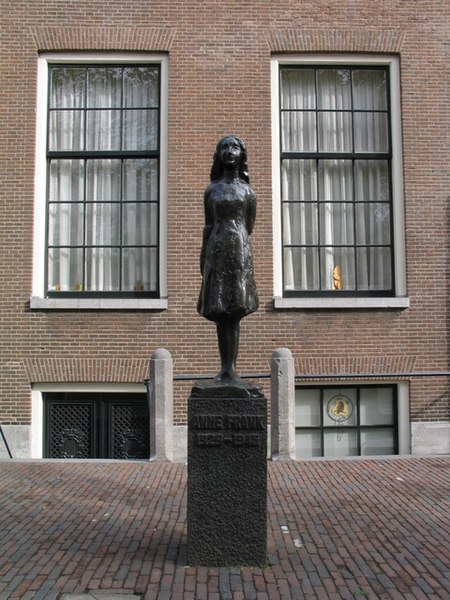History of the Jews in Amsterdam
The History of the Jews in Amsterdam focuses on the historical center of the Dutch Jewish community, comprising both Portuguese Jews originally from both Spain and Portugal and Ashkenazi Jews, originally from central Europe. The two separate groups have had a continuing presence since the seventeenth century. Amsterdam has been called a Jerusalem of the West and the "Dutch Jerusalem". The Holocaust in the Netherlands devastated the Jewish community, with the Nazis murdering some 75% of the approximately 80,000 Jews at time present in Amsterdam, but the community has managed to rebuild a vibrant and living Jewish life for its approximately 15,000 present members.
Interior of the Portuguese Synagogue, modeled after the Temple of Solomon in Jerusalem, Amsterdam 1695 by Romeyn de Hooghe
Drawing of the interior of the Talmud Tora at Houtgracht (1639), demolished in 1931
Esnoga in 1675
Statue of Anne Frank, by Mari Andriessen, outside the Westerkerk in Amsterdam.
The Holocaust in the Netherlands
The Holocaust in the Netherlands was organized by Nazi Germany in occupied Netherlands as part of the Holocaust across Europe during the Second World War. The Nazi occupation in 1940 immediately began disrupting the norms of Dutch society, separating Dutch Jews in multiple ways from the general Dutch population. The Nazis used existing Dutch civil administration as well as the Dutch Jewish Council "as an invaluable means to their end". In 1939, there were some 140,000 Jews living in the Netherlands, among them some 24,000 to 25,000 German-Jewish refugees who had fled from Germany in the 1930s. Some 75% of the Dutch-Jewish population was murdered in the Holocaust. The 1947 census reported 14,346 Jews, or 10% of the pre-war population. This further decrease is attributed to massive emigration of Jews to the then British Mandate of Palestine. There is debate among scholars about the extent to which the Dutch public was aware of the Holocaust. Postwar Netherlands has grappled with construction the historical memory of the Holocaust and created monuments memorializing this chapter Dutch history. The Dutch National Holocaust Museum opened in March 2024.

Monument at Westerbork: Each stone represents one person who was detained at Westerbork prior to being murdered in a Nazi camp
Yellow Star of David that Dutch Jews were forced to wear
Jewish woman wearing a yellow Star of David during the razzia of 20 June 1943 [nl]
This statue in Amsterdam commemorates Anne Frank, who went into hiding with her German-Jewish refugee family during the Second World War. They were found and transported. Her father survived and later published her diary.







![Jewish woman wearing a yellow Star of David during the razzia of 20 June 1943 [nl]](https://upload.wikimedia.org/wikipedia/commons/thumb/3/3e/Bundesarchiv_Bild_183-R99538%2C_Niederlande%2C_Frau_mit_Judenstern.jpg/418px-Bundesarchiv_Bild_183-R99538%2C_Niederlande%2C_Frau_mit_Judenstern.jpg)
